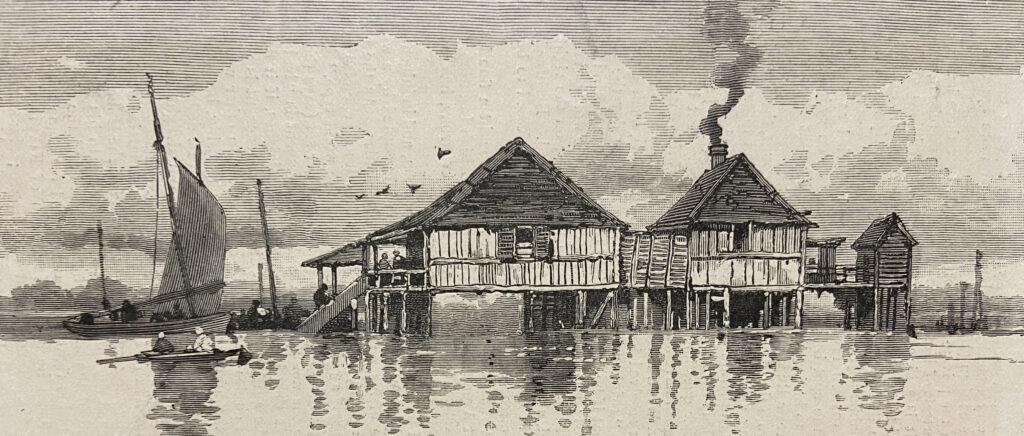
St. Malo
“The bayou may be called the street of the place, on either side of which all the houses front. They are about 100 yards apart, and all have a landing place or small wharf in front. To this are tied the luggers… all swift and sea-worthy boats, some of them capable of carrying large cargoes for vessels of their size. Sails were all spread for drying, and the bayou presented a most animated appearance.”
Charles Whitney. “St. Malo – the Times-Democrat Expedition to that Mysterious Island.” New Orleans Times-Democrat Mar. 14, 1883.
Brief History

Although the exact date the village was established is not completely certain, accounts from early settlers relate that in the 1830s Filipino seamen, or Manilamen, were living in palmetto frond huts along Bayou St. Malo. By the 1860s, St. Malo was the largest fishing village on the southern shore of Lake Borgne. It served as an outpost for boats fishing further down the coast. St. Malo was a prosperous community of over 150 Filipino fishermen who lived in large cypress buildings constructed over the wetlands. The location provided easy access to prime fishing grounds, but it also made the village susceptible to storms. Despite being abandoned early in the 20th century, the village remains significant, representing the many forgotten settlements that helped shape Louisiana history and culture and a first chapter in the story of Filipino migration to the United States.
Filipinos fished all along the coast including around the peninsula in the Gulf of Mexico. They would fish until their boats were full and only then return to St. Malo. They sold their fish to middlemen who packed them in ice and brought them to market. In 1860, the success of Filipino fishermen brought them into conflict with Spanish fishermen. The growth of St. Malo threatened the Spanish fish monopoly. At the time Lake Borgne was the primary source of fresh fish for New Orleans. New Orleanians supported the Filipino fishermen in their efforts to break the Spanish monopoly and supply more fish to the New Orleans markets.

St. Malo came to symbolize the presence of Filipinos in the region. While Filipinos integrated into St. Bernard and surrounding parishes, St. Malo remained primarily Filipino. In 1883 the Times Democrat chartered a lugger to sail from Bayou St. John in New Orleans to St. Malo. The trip provided us with two accounts of St. Malo one written by Lafcadio Hearn for Harper’s Weekly and another by Charles Whitney for the Times Democrat. Much of what we know about St. Malo comes from these two sources. The images you see here were sketched by J.O. Davidson and were printed alongside Hearn’s account.
St. Malo was eventually abandoned. Storms destroyed St. Malo every 10 to 20 years. By the end of the 19th century, the dangers of living at St. Malo outweighed the benefits. The Cheniere Caminada hurricane of 1893 swamped all of the one-story buildings at St. Malo. The few survivors were able to ride out the storm on the second floor of one building. After they were eventually rescued, they swore never to return to St. Malo. At the beginning of the 20th century, Filipinos found other opportunities in South Louisiana. The shrimp drying industry was booming in Barataria Bay which was lined with towns more accomodating to fishermen with families. About 100 Filipinos were at St. Malo in 1906 when another storm hit the region. They were all thought to have perished.

Manilamen
The first Filipino settlers of Louisiana were Filipino sailors, Manilamen, who left their vessels for opportunities on the Gulf Coast. Manilamen may have arrived in the area in the late 18th century when both the Philippines and Louisiana were Spanish colonies. New Orleans was one of the busiest ports in the US through the 19th century and Filipinos were known as accomplished seamen. It’s natural that Filipinos working on vessels sailing the Gulf of Mexico would find their way to Louisiana. Eventually, some decided to settle in the sparsely populated Louisiana wetlands. Their skills as boatmen and fishermen allowed them to make a life for themselves. They established villages on St. Malo Bayou and on coastal islands in Barataria Bay. The success of the early pioneers led to other Filipinos setting sail to Louisiana with the intent of settling in the state.
Why St. Malo?
- Spanish-speaking Filipinos would have been at home in St. Bernard where, in the 19th century, it was said that “everyone in St. Bernard parish spoke Spanish.”
- Louisiana was sparsely populated and rather welcoming to settlers who were willing to work in labor-intensive areas like fishing and trapping.
- St. Malo had an abundance of seafood that anyone with a boat and net could harvest for a decent profit.
- Other fishermen were unwilling to live at St. Malo which was a swampy area where the line between water and land was unclear.
- They were drawn to St. Malo by the success stories of early Filipino pioneers and the idea of a Filipino village in the US.
La. State Historical Marker
The Philippine-Louisiana Historical Society (PLHS) requested approval from the state of Louisiana to erect the “St. Malo” Louisiana State Historical Marker. PLHS submitted an application to the Louisiana Historical Marker Program. The wording of the marker was carefully considered. PLHS submitted sources and sound justification for the marker text which was approved by the LSU History Department and the Louisiana Tourism Development Commission.
St. Malo wa the first permanent Filipino settlement in the United States. In the first half of the 19th century, Filipino sailors established a village on the southern shore of Lake Borgne on a site previously settled by Native Americans and Maroons. By the mid-19th century, St. Malo was the largest fishing village on the lake and a symbol of the growing Filipino presence in Louisiana.
“St. Malo” Louisiana State Historical Marker. Philippine-Louisiana Historical Society, St. Bernard, LA, 9 November 2019.
Marker Unveiling
The Philippine Louisiana Historical Society unveiled the St. Malo Historical Marker Saturday, November 9, 2019. The event brought out the Filipino community to celebrate the long-awaited event. Dignitaries from the Philippine Consulate in Houston and the St. Bernard Parish government attended the festivities. The unveiling was concluded with a formal gala featuring Filipino food and folk dances.
“The residents of St. Malo were pioneers, exploring a region others thought was dangerous and uninhabitable. They made a good living, because they were willing to live deep in the marsh, giving them easy access to a ready supply of fish, oysters, and shrimp. Storms, economic migration, and assimilation led to St. Malo being abandoned early in the 20th century.”
Randy Gonzales. St. Malo Marker Unveiling Speech, November 9, 2019.
TFC Video
TFC Balitang American was one of several media outlets to cover the unveiling of the St. Malo marker. TFC distributed the following segment on their online news channel.
Note: The video cites an unsupported claim that Filipinos founded St. Malo in 1763. There is no historical evidence to support this claim. Filipinos may have been living along Lake Borgne at the time, but it is unlikely they settled at St. Malo at that time. Juan St. Malo and his community of maroons controlled the area up until the Spanish captured him in 1783. The Filipino settlement at St. Malo was probably established in the 1830s with Filipinos coming from other Louisiana locations to establish the fishing village.
Sources
Espina, Marina. Filipinos in Louisiana. New Orleans: A.F. Laborde, 1988.
Gonzales, Randy. “Stories Told About the Nineteenth Century Filipino Settlement at St. Malo, Louisiana.” Louisiana Folklore Miscellany: 29 (2019): 5-22.
Hearn, Lafcadio. “Saint Malo: A Lacustrine Village in Louisiana.” Harper’s Weekly: A Journal of Civilization 31 Mar. 1883: 196-99.
Salgarolo, Michael. “Journeys to St. Malo: A History of Filipino Louisiana.” Rethinking History: The Journal of Theory and Practice 25 (1): 77-114.
Whitney, Charles. “St. Malo – the Times-Democrat Expedition to that Mysterious Island.” New Orleans Times-Democrat Mar. 14, 1883.
In the News
“Mix Mix.” Take Out. Created by Lisa Ling, season 1, episode 1, Part2 Productions, 2022. HBOMax.
“Climate Change is Destroying an Important Piece of Filipino American History.” Now This News, Group Nine Media, 2 December 2021.
Ramirez, Rachel. “This Site is an Important Piece of Filipino American History. Climate Change is Destroying It.” CNN, Cable News Network, 17 October 2021.
Sandweiss, Ethan. “The Challenges of Reclaiming Filipino Louisiana’s Centuries-Old History.” Atlas Obscura, Atlas Obscura, 10 September 2021.
Tayag, Yasmin. “Remembering America’s First Filipino Settlement before It Vanishes into the Sea.” HuffPost, HuffPost, 24 June 2021.
Visit St. Malo Marker
The St. Malo historical marker is located at the Los Isleños Museum Complex at 1345 Bayou Road, St. Bernard, LA. The marker aligns with the Los Isleños Heritage and Cultural Society’s mission to recognize the varied histories and cultures that helped shape the area.
“To understand the history of St. Bernard Parish, you have to know about the Filipinos that first settled here. They are part of our cultural identity. Filipinos lived alongside Isleños for many generations. They intermarried and influenced each other.”
William Hyland, St. Bernard Parish Historian and Director of the Los Isleños Museum Complex
Los Isleños Museum Complex at 1345 Bayou Road, St. Bernard, LA.
Last updated: April 5, 2022.


